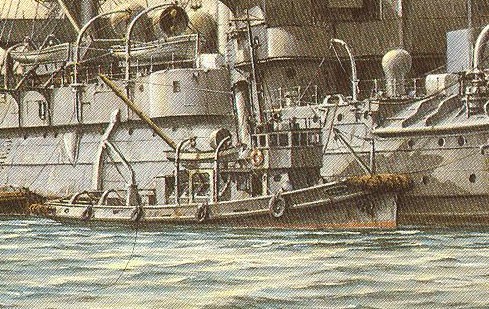KYUNANSEN

|
(Salvage Tug by Takeshi Yuki scanned from "Color Paintings
of Japanese Warships")
IJN Rescue and Salvage Ship YUSHO MARU:
Tabular Record of Movement
© 2009-2010 Bob Hackett and Peter Cundall
26 May 1927:
Aioi. Laid down at Kobe Steel as a 807-ton salvage vessel for Teikoku Salvage K.K..
30 October 1927:
Launched and named YUSHO MARU. [1]
25 January 1928:
Completed.
26 October 1930:
Departs Kobe on naval maneuvers.
1934:
Ownership transfers to Nipponkai Nankyo.
2 September 1937:
Kowloon Bay, Hong Kong . During a typhoon, Nippon Yusen Kaisha’s (NYK) (Japan Mail Steamship Co.) 16,975-ton liner ASAMA
MARU is driven aground by the storm.
12 September 1937:
YUSHO MARU engages in refloating ASAMA MARU.
12 July 1940:
Owner becomes Japan Salvage Co.
14 December 1941:
At the Sasebo Navy yard start of equipment construction
18 December 1941:
Requisitioned by the IJN. Departs Moji.
19 December 1941:
Arrives at the Sasebo Navy Yard.
20 December 1941:
Begins conversion to a an auxiliary salvage vessel. Registered
in the Sasebo Naval District.
26 December 1941:
The conversion is completed.
27 December 1941:
Departs Sasebo. That same day in the
South China Sea, 30 nms SW of Hong Kong, LtCdr David A. Hurt’s USS PERCH
(SS-176) torpedoes and blows the bow off supply ship NOJIMA (NOSHIMA) at 22-14N,
115-13E. NOJIMA is beached.
30 December 1941:
YUSHO MARU arrives at Mako.
31 December 1941:
Departs Mako. YUSHO MARU is assigned directly to the Combined Fleet. That same day, at Lingayen, Philippines, coast defense ship IZUMO hits a mine and is damaged
1 January 1942:
30 nms SW of Hong Kong. YUSHO MARU arrives at Chuan Wei Bay and engages in life-saving service for transport NOJIMA.
28 January 1942:
Departs Chuan Wei Bay towing NOJIMA.
29 January 1942:
Arrives at Hong Kong.
2 February 1942:
Departs Hong Kong.
4 February 1942:
Arrives at Lingayen.
5 February 1942:
Departs Lingayen towing coast defense ship IZUMO.
9 February 1942:
Arrives at Hong Kong. Later, IZUMO undergoes
battle-damage repairs.
14 February 1942:
Off Davao, Philippines. LtCdr (later Rear Admiral)
Chester C. Smith’s USS SWORDFISH (SS-176) torpedoes and damages AMAGISAN MARU.
17 February 1942:
YUSHO MARU departs Hong Kong.
23 February 1942:
Arrives at Davao and engages in life saving service
for transport AMAGISAN MARU.
28 February 1942:
Submarine I-5 runs aground on a reef in the north passage of Staring Bay, Celebes.
5 March 1942:
YUSHO MARU arrives at Davao.
8 March 1942:
Arrives at Makassar, Celebes.
9 March 1942:
Departs Makassar.
10 March 1942:
YUSHO MARU arrives at Staring Bay and successfully salves I-5 from the reef. I-5 then undergoes repairs by SubRon 2's tender SANTOS MARU.
26 March 1942:
Departs Staring Bay.
28 March 1942:
Arrives at Makassar.
2 April 1942:
Departs Makassar.
5 April 1942:
Arrives at Surabaya, Java. YUSHO MARU’s crew participates in an investigation and processing of a boat sinking.
10 April 1942:
Attached to the Department of the Navy's 11th special construction section.
6 January 1943:
YUSHO MARU is ordered on completion of current duties to salvage YOSHIDA MARU No. 1 and then continue to salvage damaged ships at Ambon.
6 January 1943:
Near Kai Island, Banda Sea. Torpedo boat TOMOZURU is damaged in an attack by USAAF aircraft and goes dead in the water.
9 January 1943:
Departs Surabaya.
11 January 1943:
Arrives at Zandbuis Banken (Pulau Sadapur), 07-45S, 117-14E, Groote Paternoster Eilanden (Kepulauan Tengah), in the Banda Sea area.
15 January 1943:
Departs Zandbuis Banken towing TOMOZURU.
16 January 1943:
Arrives at Ambon, Moluccas, NEI.
26 January 1943:
Departs Ambon.
6 February 1943:
Arrives at Surabaya.
6 March 1943:
Departs Surabaya.
11 March 1943:
Arrives at Ambon.
13 March 1943:
Departs Ambon.
15 March 1943:
Arrives at Babo, Maccluer Gulf, Dutch New Guinea.
28 March 1943:
Departs Babo.
29 March 1943:
Arrives at Bula, Ceram (Seram), S of Halmahera, Moluccas.
1 April 1943:
Departs Bula.
2 April 1943:
Arrives at Ambon.
8 April 1943:
Departs Ambon.
15 April 1943:
Arrives at Surabaya.
5 May 1943:
Departs Surabaya.
7 May 1943:
Arrives at Djakarta, Java. Drydocked. Undergoes repairs.
2 June 1943:
Completes repairs.
3 June 1943:
Departs Djakarta.
15 June 1943:
Arrives at Surabaya.
1 July 1943:
Makassar Strait. LtCdr Harry Hull's USS THRESHER (SS-200) torpedoes and
damages destroyer HOKAZE that is grounded in Sibaya harbor, Celebes, to prevent sinking and to permit salvage.
4 July 1943:
YUSHO MARU departs Surabaya.
13 July 1943:
Arrives at Sibaya harbor, Palu Bay.
19 July 1943:
Departs Sibaya harbor with HOKAZE.
22 July 1943:
Arrives at Makassar.
31 July 1943
Departs Makassar with HOKAZE.
August 1943:
YUSHO MARU arrives at Surabaya with HOKAZE. The
destroyer undergoes repairs.
11 August 1943:
Arrives at Makassar.
12 August 1943:
YUSHO MARU arrives at the site (05-30S, 120-48E)
where the day before LtCdr John A. Tyree’s USS FINBACK (SS-230) torpedoed and
damaged 6,343-ton auxiliary vessel TATSUMIYA MARU bound for Singapore.
15 August 1943:
Arrives at Makassar with TATSUMIYA MARU.
19 August 1943:
Departs Makassar.
23 August 1943:
Arrives at Surabaya with TATSUMIYA MARU.
4 September 1943:
Departs Surabaya. In Surabaya's North Channel, YUSHO MARU strikes a mine, but is salvaged by OKUYO MARU that takes her under tow.
5 September 1943:
Makassar Strait. On the way back to Surabaya while under tow, YUSHO MARU strikes another mine and sinks at 05-00S, 119-00E.
1 November 1943:
Removed from the Navy List. [2]
16 May 1944:
Salvage Ship ARABATO MARU (ex-Dutch GMM ALBATROS) begins salvage work on YUSHO MARU.
12 July 1944:
YUSHO MARU is successfully refloated.
3 October 1944:
ARABATO MARU tows YUSHO MARU into Surabaya. [3]
Authors' Note:
[1] Also rendered YUSYO MARU.
[2] Some sources incorrectly list YUSHO MARU as sunk by bombs off Formosa in 1944.
[3] Postwar, YUSHO MARU does not appear on the list of vessels captured by the Allies in former Allied territory. It is probable that the wreck was deemed a constructive total loss and scrapped.
- Bob Hackett and Peter Cundall.
Back to
Salvage and Repair Tugs Page





